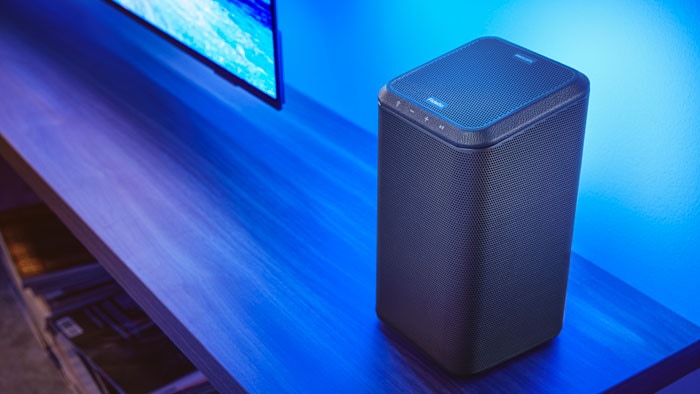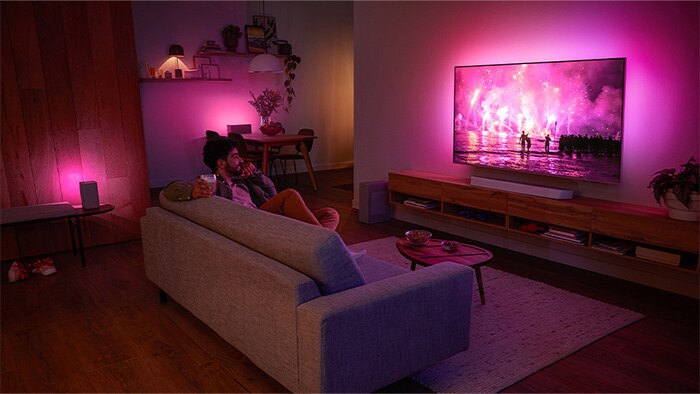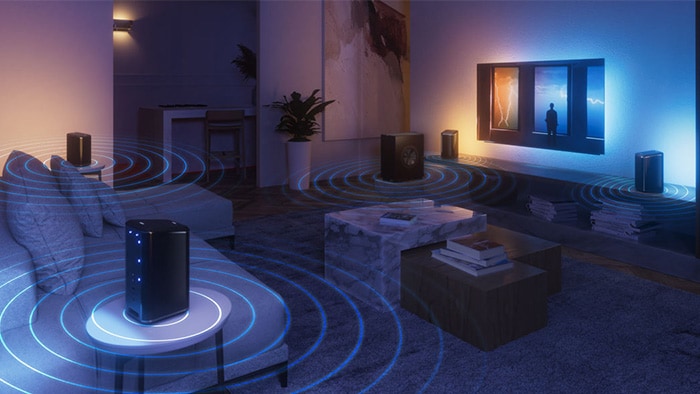What is the best soundbar for you?
A soundbar can be a great way to unlock instantly more cinematic sound for your new, 4K TV. But with so many options out there, it’s tricky to know where to start.
We’ll run you through the key questions to ask to help filter what’s out there and give you a quick explanation of some of the killer features to look out for.

Do I need a soundbar?
Before diving into how to choose a soundbar, it’s important to work out if a soundbar’s the right choice for you.
A soundbar is an easy, effective way to add drama and clarity to what you watch, often delivering a fuller sound, better bass, and clearer dialogue than what your TV speakers are capable of. For most people, it’s a great choice for upgrading their TV sound.

When do you not need a soundbar?
There are only a couple cases we wouldn’t recommend a soundbar:
These already feature a dedicated sound enclosure. Instead, consider a subwoofer, like the Fidelio FW1, or Wi-Fi surround speakers, like the Fidelio FS1.
For that, try starting with a pair of Wi-Fi speakers like the Fidelio FS1 or W6205 in stereo, with your TV as the centre channel. We explain how that works, in our article on building your home cinema.
How to choose a soundbar
Once you’ve worked out if a soundbar is for you, here are five questions to answer for yourself to help narrow the search.
If there’s not much space between your TV and the cabinet, you might be looking for something ultra-compact, like the B6309. Similarly, think about the size of your room. Sure, you want to fill it. But the walls don’t have to shake.
Is the primary purpose of your soundbar to make it easier to follow dialogue? In that case, consider a 3.1 soundbar like the B8907 which features a channel dedicated to dialogue.
This isn’t often a problem. Most soundbars feature multiple ways to connect. But if you have a TV with HDMI ARC or eARC, you might want a soundbar that can make the most out of its possibilities for higher quality surround sound.
If you’re thinking of expanding your home cinema setup explore how easy it is to add extra speakers. All Philips sound products are designed to work with each other and your Ambilight TV. We call this Ambilight TV surround.
There are plenty of options out there. From the more affordable to the more premium. Defining a budget from the start can save you from getting lost in the scroll.
Answering these questions can help focus your search and point you to the features most relevant to you.
What do soundbar channels mean?
Numbers like 2.1 and 5.1.2 might feel like a spooky return to maths classes. But they just tell you how many speakers a soundbar has and what those speakers do. Generally, the higher the figures, the richer and more immersive the sound. The first number stands for how many channels there are. The second number tells you how many subwoofers (those are the speakers that take care of the lower frequencies for a creamier, more rumbly bass).
If there’s a third number in there, like in 5.1.2 or 7.1.2, it’s for how many upward-firing speakers there are. These make it feel like the sound is coming above you, rather than just in front or around you, for a full, 3D effect.
Let’s look at some examples.
2.1 Soundbars
These feature left and right channels and a subwoofer. With its powerful speakers and added sub, a 2.1 soundbar like B6309 could already be a step up from your TV sound.
3.1 Soundbars
3.1 soundbars add a centre channel to the mix. The centre channel takes over all the dialogue duties, so dialogue comes across with crunchy precision.
3.1.2 Soundbars
With the addition of two upward-firing channels, 3.1.2 soundbars like the B8907 give you a more realistic, 3D feeling of spaceships and rockets roaring overhead.
5.1.2 Soundbars
5.1.2 soundbars, like the B7908, build on 3.1.2 setups by adding two side-firing channels—to give you an even fuller surround sound effect.
7.1.2 Soundbars
7.1.2 soundbars such as the Fidelio FB1 add left and right rear speakers, for the most immersive, 360° wrap of sound.
Soundbars with subwoofers
When looking at soundbars with subwoofers, you’ll come across two types: those with bass speakers built-in, and those with a separate, standalone sub.
Built-in subwoofers
These are when the soundbar itself contains dedicated speakers to handle lower frequencies. There are no extra wires, setup, or space needed.
Standalone subwoofers
Some soundbars, like the B6309, come with a separate, free-standing subwoofer. This goes on the floor and often connects to your TV wirelessly. The speakers in standalone subs are often larger and more powerful, giving you a more impressive bass.
What are DTS:X and Dolby Atmos soundbars?
If you’re after the most detailed, cinematic surround sound there is, look out for a soundbar with DTS:X and Dolby Atmos.
Because they preserve all the detail and nuances of what you watch, some have likened DTS:X and Dolby Atmos to 4K for your ears.
In reality, they are both what are known as object-based surround sound formats. This means you hear what’s on screen as if it were happening in the space around and above you.
To enjoy Dolby Atmos and DTS:X, you’ll need compatible content and a compatible soundbar, like the Fidelio FB1, B7908, or B6309.
More and more streaming services support Dolby Atmos, while DTS:X is used in IMAX Enhanced certification and is often the format used for physical Blu-ray discs—so compatibility is sometimes seen as a sign of how future-proof your soundbar will be.
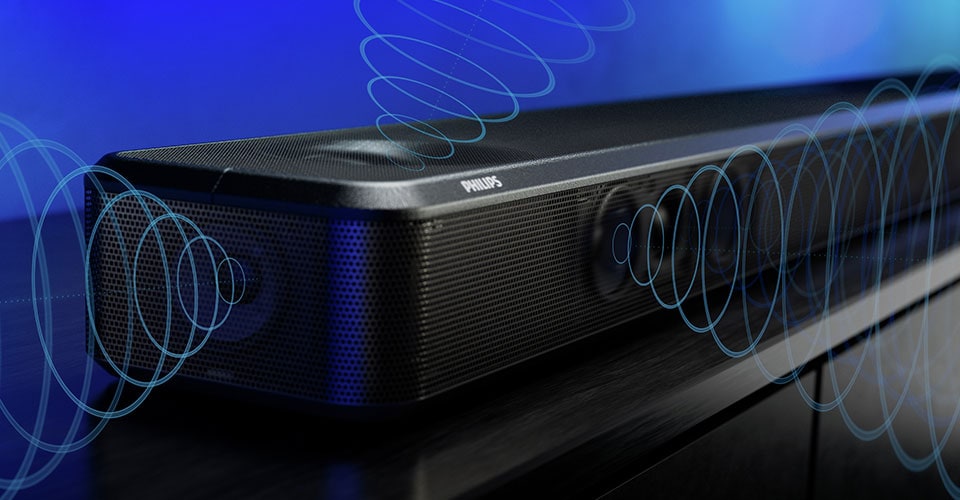
What are HDMI eARC and HDMI ARC?
There are different ways to connect your soundbar to your TV, depending on which connections each supports. Not all connections are created equal. HDMI ARC and eARC, allow huge amounts of uncompressed data to be transferred at lightning speeds. This is what makes a full surround sound experience possible. HDMI eARC is the latest of the two. It allows you to send up to 32 channels of audio from your TV to your sound system, including 8-channel, 24bit/192kHz of uncompressed data streams at up to 38Mbps.
This lets you enjoy all that juicy Dolby Atmos and DTS:X goodness, as well as high bitrate formats like Dolby TrueHD and DTS-HD Master Audio which are available on Blu-ray discs and an increasing number of streaming services.
It’s worth checking if your TV includes an HDMI eARC or ARC slot. If it does, we’d recommend at least considering a soundbar that also supports it, like the Fidelio FB1, B7908.
What is Ambilight TV Surround?
For some, a soundbar will be the answer to all their sound needs. For others, it’ll just be the start of an epic, home cinema setup. If you think you might want to add sound products in the future, it’s handy to know they’ll all work together. That’s why all Philips soundbars, speakers, and subwoofers are designed to work together seamlessly and get the most out of your Ambilight TV. We call this Ambilight TV Surround.
It means, if you’d like to add an extra subwoofer or a pair of Wi-Fi speakers, like the Fidelio FS1, with Ambilight responsive LEDs, you can do so, confident it won’t cause any fuss.
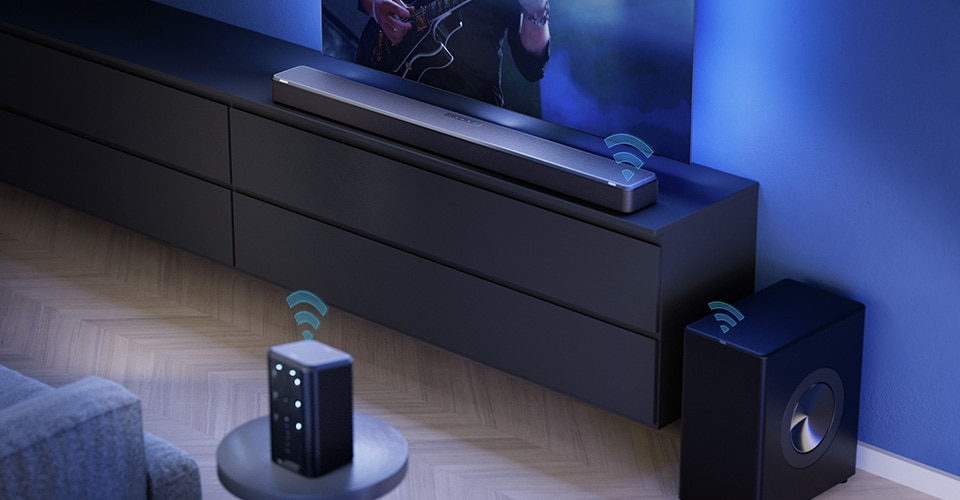
Conclusion
For some, a soundbar will be the answer to all their sound needs. For others, it’ll just be the start of an epic, home cinema setup. If you think you might want to add sound products in the future, it’s handy to know they’ll all work together. That’s why all Philips soundbars, speakers, and subwoofers are designed to work together seamlessly and get the most out of your Ambilight TV. We call this Ambilight TV Surround.
It means, if you’d like to add an extra subwoofer or a pair of Wi-Fi speakers, like the Fidelio FS1, with Ambilight responsive LEDs, you can do so, confident it won’t cause any fuss.
Our favourite Philips soundbars
Model | Channels | Type of subwoofer | RMS (W) | Surround sound formats | Connectivity |
| 7.1.2 | Built-in | 310 | Dolby Atmos DTS:X | eARC/ARC | |
| 5.1.2 | Standalone | 370 | Dolby Atmos DTS Virtual:X | eARC/ARC | |
| 3.1.2 | Standalone | 300 | Dolby Atmos | eARC/ARC | |
| 2.1 | Standalone | 160 | Dolby Atmos | eARC/ARC |
-
- Dolby Atmos. IMAX Enhanced
- Philips Wireless Home System
- 620 W max. Built-in subwoofer
- Easy room calibration
-
Soundbar 3.1.2 with wireless subwoofer
TAB8907/10
- 720 W max. Wireless subwoofer
- Dolby Atmos. Cinema Experience
- Play-Fi. Home Sound Made Easy
- Connects with voice assistants
-
Soundbar 3.1 with wireless subwoofer
TAB8507/10
- 600 W max. Wireless subwoofer
- Dolby Atmos. Cinema Experience
- Play-Fi. Home Sound Made Easy
- Connects with voice assistants



